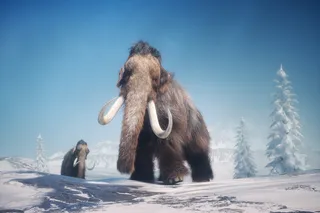Archaeologists in New Zealand have recently uncovered nine new penguin specimens from the Paleocene Epoch, which occurred between 66 million years ago and 56 million years ago. Researchers have assigned the largest of these nine specimens to a new species known as Kumimanu fordycei.
According to the study published by Cambridge University Press, based on humerus length and humerus proximal width, K. fordycei weighed anywhere between 148 kilograms (326 pounds) and 159.7 kilograms (352 pounds).
A Large Penguin Ancestor
K. fordycei's size is not the penguin's only surprising detail. According to researchers, K. fordycei sits incredibly close to the root of the modern-day penguin evolution tree.
Researchers found one fossil of K. fordycei that weighed the bird in at 300+ pounds. For reference, emperor penguins (Aptenodytes forsteri) — the largest penguins that exist today — typically weigh around 50 pounds when fully grown.
The massive size of K. fordycei and its location in the penguin's evolutionary tree suggests that penguins likely hit their evolutionary size limit early on. This would explain why, like many other animals on Earth, they have become smaller over millions of years.
"Given that the earliest giant New Zealand penguin fossils pre-date the occurrence of penguins on other continents, it is tempting to speculate that penguins approached the peak of their known body size distribution while still restricted to their Zealandian center of origin," researchers wrote in the study.
However, researchers also acknowledge that this hypothesis remains unproven, since there are "untested gaps" in the Paleocene marine record of the Southern Hemisphere.
Other Large Animal Ancestors
While the discovery of K. fordycei has broken records for penguins, it's far from the first ancestor of a modern-day animal that has made headlines.
In 2015, two giant rhino fossils were found in China. Giant rhinos were the largest land animals to ever live, and according to fossil records, they could stand up to 20 feet tall and weigh as much as 20 tons. These specific fossils were around 22 million years old, and discrepancies in bone structure allowed researchers to classify them as a new species.
Other modern-day animals with giant ancestors include sloths, eagles and even bears.
Read More: 5 Of The Biggest Animals To Ever Live On Earth
Megatherium is an extinct genus of ground sloth that could grow up to 9 feet long and weigh up to 550 pounds. Unlike modern-day sloths, they did not live in trees, instead they maneuvered on the ground and used their length to reach leaves.
Haast's eagle, meanwhile, was the largest eagle ever to live. Its wingspan could get up to 10 feet in length and it weighed up to 33 pounds. For reference, the Harpy eagle — the largest eagle on Earth today — grows up to just 20 pounds.
Finally, the short-faced bear is the largest bear to have ever existed on Earth. Before going extinct around 11,000 years ago, the short-faced bear terrorized smaller creatures in its habitat, as they could reach well over 11 feet in height when standing upright. Today's largest bears, Kodiak brown bears, can reach up to 10 feet in height while standing.














